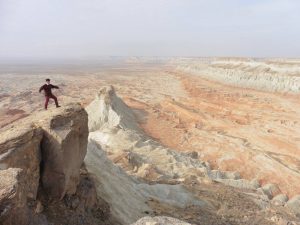We’ve always taken interesting people to even more interesting destinations. It now happens to include an area commonly referred to as Central Asia. By Central Asia, we refer to the five ex-Soviet ‘Stans: Kazakhstan, Kyrgyzstan, Tajikistan, Uzbekistan, and Turkmenistan. It’s one of the least known, least travelled parts of the world and as such we get some pretty amazing questions, from the downright ridiculous such as “No, that’s not a real place. Surely you’re making this up?” to the simply misinformed such as “Isn’t that where ISIS is?”
While it would take eons to write down all these types of questions and in the specific manner in which they are asked, what we’ve done is grouped together some of the types of questions we do get most commonly.
Q) Is it safe?
A) The ‘Stans are surprisingly safe. A common misconception is that Central Asia is somehow interlocked with the problems in the middle east or those nearby in Pakistan and Afghanistan. No doubt it is because they have ‘stan’ in their names. The truth of the matter is that Turkmenistan is one of the safest places one could visit, while Uzbekistan, Kyrgyzstan, and Kazakhstan are all at least as safe as most Central/Eastern European destinations. There is very little petty crime and violence on the street is just about unheard of. The only concern, though still minor, is if you are travelling by yourself you might encounter a corrupt policeman.

Q) Are they Muslims?
A) The short answer is yes, most people in Central Asia are Muslims. But in saying that, more often than not, it is in the same sense that most people in Australia, Britain or France are Christians. It’s more of a cultural identification than a religious one. One thing the Soviet Union did and did well was to beat religion out of people. At one point in Kazakhstan and Turkmenistan for example, there was only one mosque in each country. Even before the Soviets came, Islam’s influence in the region was minimal. A famous quote is that the people of Central Asia “took as much Islam with them as they could fit in their saddlebags”. Another question of this mould is “Do women need to cover up?” to which anyone who has ever been to a beach in a former Soviet Union will respond, “the only thing you might need to cover is your eyes”.
Q) Are they ‘dry’ countries?
A) This question almost always follows on from the last question. The answer is the most resounding “no” that is possible. Central Asians drink like fish. Fish with drinking problems. They love their vodka and cognac, just to name a couple of favourites, and they are mostly drunk straight. Beer is at best a refreshing beverage to enjoy as one might have juice and is reserved mostly for women and children. In this way, they have taken after their former Russian overlords.
Q) What’s the food like?
A) Occasionally you can come across some of the most delicious and succulent marinated meat you may ever have eaten, but at other times you will feel like you’re eating leather. One thing is for sure, the variety is minimal and Central Asia is certainly not a great place for vegetarians. On one tour we had an amazing individual, but unfortunately, his vegetarianism meant he mainly ate chips (French-fries for the Americans out there) until he managed to find a box of cereal. Of course in the cities, there are more options than in the country, and there are some local dishes that you might really like, but all in all, this isn’t a region to be visited for its fine cuisine.
Q) Is it really backwards?
A) So many of the questions we get are along the lines of “Do they have internet?” “Do they have a television?” “Do they live in houses?”. Being part of what was the second world meant that the basic infrastructure and the social safety net was developed to a reasonable standard. Today you will find all your worldwide sport live on satellite TV. You’ll be able to read your emails and watch Netflix and while some small communities, not unlike the indigenous people you might find in North America or Australia, live more traditional lifestyles, most people live in anything from brand new modern condos and skyscrapers, lovely quarter acre blocks with large houses to brutalist Stalinist reinforced concrete Soviet style apartment blocks.
Of course the most common question/statement of all is:
Q) Isn’t that where Borat was made? (Kazakhstan)
A) Which of course, as many of you will know, is simply not true. Borat was filmed in Romania, using a language derived from Polish and Yiddish and more closely resembles certain aspects of Europe than could ever be the case here in Central Asia. The actor Sacha Baron Cohen is a pretty good British comedian/actor of the Jewish faith and certainly isn’t a Kazakh.





